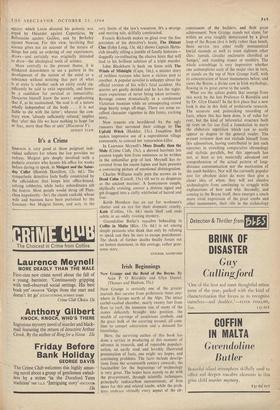Irish Beginnings
New Grange and the Bend of the Boyne. By Sean P. 0 Rforddin and Glyn Daniel. (Thames and Hudson, 35s.)
NEW Grange is certainly one of the greater marvels that survive from prehistoric times any- where in Europe north of the Alps. The intact corbel-vaulted chamber, nearly twenty feet from floor to roof, the immense size of many of the stones delicately brought into position, the wealth of carvings of auspicious symbols, and the great bulk of the covering mound, all com- bine -to compel admiration and a demand for knowledge.
Here, the surviving author of this book has done a service in producing at this moment of advance in research, and of reputable populari- sation, an easily read and lavishly illustrated presentation of facts, one might say hopes, and continuing problems. The facts include descrip- tions from the seventeenth century onwards; the fascinatityxr for the beginnings -of—archwology is very great. The hopes have mostly to do with the procurement, through scientific techniques, principally radiocarbon measurement, of firm dates for this and related tombs, while the prob- lems embrace virtually every aspect of the cir-
cumstances of the builders, and their great achievement. New Grange stands not alone, for within an area roughly demarcated by a great loop of the Boyne (brti is belly rather than bend), there survive two other really monumental burial mounds as well as some eighteen other sltes: tumuli, circular enclosures classified as `henges,' and standing stones or menhirs. The whole assemblage is very impressive whether one contemplates each of the major sites in turn, or stands on the top of New Grange itself, with its concentration of lesser monuments below, and views the Boyne, a divine cow in Irish mythology, flowing in its great curve to the south.
What are the salient points that emerge from this work by the late Professor 0 Rfordain and by Dr. Glyn Daniel? In the first place that a new look is due in this field of prehistoric research. The accurate and painstaking recording of facts, where this has been done, is of value for ever, but the kind of inferential structure built up rests on far too frail a foundation to merit the elaborate repetition which can so easily appear as dogma to the general reader. The present reviewer does not exclude himself from this admonition, having contributed to just such exercises in stretching comparative chronology and stylistic parallels, but this approach has not, at least as yet, materially advanced our comprehension of the actual pattern of long- distance communication nor the motivation of the tomb builders. Nor will the currently popular zest for absolute dates do more than give a closer idea of when; they will not absolve archwologists from continuing to struggle with explanations of how and why. Secondly, and coming to the Boyne itself, there emerges a much more vivid impression of the great tombs and other monuments, their role in the archaeology of Ireland, and of Irish tradition, than has been hitherto obtainable.
For this reason alone, the book must be in the hands of all who have visited New Grange, or ever hope to go there. Finally, special notice must be taken of the plates. There are seventy photographs incorporating a wide range of the stone cut art, if such it can be called. Many are impressive details showing the techniques of percussion surface treatment and pattern making. The subjects range over all the more remarkable decorated stones in Ireland, and include a stone each from Wales and Brittany for comparison. Equally eye-catching are a series of air photo- graphs of New Grange, and of the two other great neighbouring mounds, together with those of the large circular earthworks whose presence and significance are now properly brought to attention. A buried landscape of more recent times is well illustrated in the air photograph of one group of the Lochcrew chambered cairns where ridge and furrow cultivation reached up to surround these stony piles on a ridge about 900 feet above sea level. An impressive, almost symbolic picture: The text might have been revised more carefully. There are some errors in orienta- tion hardly due to the hospitality at Slane, and it is necessary to mention that the Boyne flows north-east, not north-west, and that Fourknocks and the coastal group lie east of Tara. Saggart Hill does not lie in this group, but, as correctly stated farther down p. 98, it is south-west of Dublin. Dundalk and Trim are not accurately placed on the maps, and a site Blessington in one is presumably the same as Seefin in another, and as mentioned in the text under variant spellings. These minor blemishes do not detract from the overall usefulness of the book.
T. G. E. POWELL



































 Previous page
Previous page